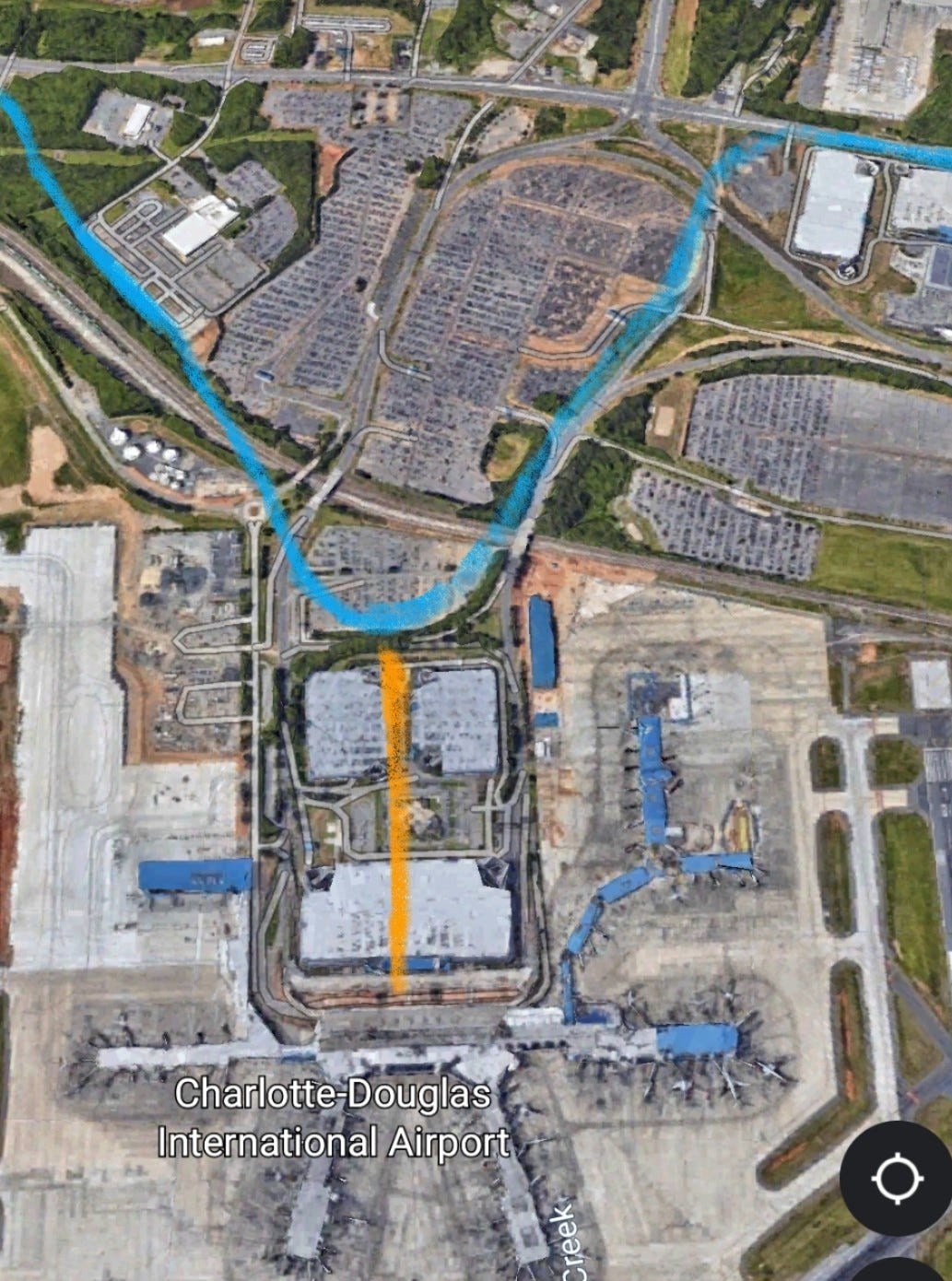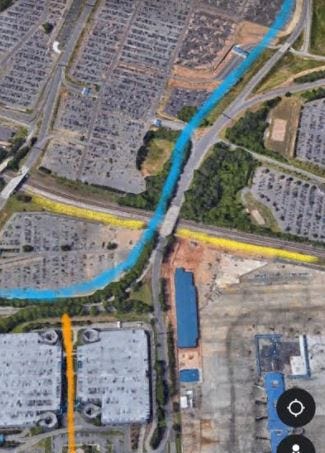You’re reading Transit Time, a weekly newsletter for Charlotte people who leave the house. Cars, buses, light rail, bikes, scooters … if you use it to get around the city, we write about it. Transit Time is produced in partnership among The Charlotte Ledger, WFAE and the UNC Charlotte Urban Institute.
CATS chief cites ‘blast radius’ and low ridership projections; airport says rail line could hinder future expansions
by Steve Harrison
Charlotte’s proposed Silver Line will have an airport station. But the light rail stop will be a mile from the airport terminal.
That’s caused pushback from some City Council members and the former transit director, Ron Tober. They ask: Why not bring the light-rail line closer to the ticketing area so it’s more convenient for passengers?
The current plan calls for a station on Wilkinson Boulevard. Passengers would get off the train at the airport stop and then take a people mover (which hasn’t been designed yet) or a bus to the terminal.
Last month, CATS chief executive John Lewis discussed the Silver Line airport station with the City Council’s transportation committee — and why, in his view, a train near the terminal won’t work.
He said bringing the train close to the terminal would be a “fatal flaw” that would “create a potential security concern in relation to blast radius in protecting the railroad and runway assets.” He also said that a train would likely enter FAA-mandated “Runway Protection Zones” that are meant to be clear of roads or buildings.
Having the station on Wilkinson Boulevard would help redevelop the area and would save money. It would also make it easier to reach Gaston County.
Lewis also said that CATS doesn’t anticipate many passengers will ever use the train to get to the airport. He said airport workers will mostly use the station, and they already take a shuttle to the terminal today.
Here is a screenshot from a presentation Lewis gave to City Council. It was meant to show the difficulties of bringing light rail close to the airport:
Former CATS chief executive Ron Tober, in an earlier interview with Transit Time, said asking people to get on a second train is too much hassle and that “a lot of people aren’t going to use it to get there.”
Tober added: “I think there are some red herrings being thrown around.”
A difficult layout
To start, it’s important to understand that the layout of Charlotte Douglas makes it difficult to bring a train close to the terminal.
To reach the ticketing area, the airport access roads are in the shape of a horseshoe. Any train that wants to reach the terminal would have to follow those roads, taking a turn to the south and then a turn to the north.
And there isn’t much physical space to bring a train adjacent to the terminal.
But what about a compromise plan that would bring the Silver Line inside the airport — but with a station just north of the two daily parking decks?
That would give the train more room to get in and out. Passengers would be about 2,200 feet from the terminal. That’s a little more than 1/3 of a mile — but passengers walk that distance today when they go from one end of the E Concourse to the A Concourse.
(The airport has also discussed one day building a future terminal/check-in area for passengers. A station north of the daily parking decks could be very close.)
Here is a homemade map of that alignment, with the train in blue and a walkway to the terminal in orange:
Are the reasons valid?
So let’s go through the reasons listed as to why a train to the airport wouldn’t work.
Lewis, the CATS chief executive, said FAA Runway Protection Zones would make it difficult to bring a train close to the terminal. But those RPZs extend only 2,500 feet from the end of runways. That would not interfere with the Silver Line alignment.
Lewis also talked about the difficulties in crossing the Norfolk-Southern freight railroad tracks that run east-west just north of the runways. Lewis said CATS would have to either build a bridge over the railroad tracks or build a tunnel under them.
Here’s a photo with the railroad in yellow:
But a light-rail bridge could follow the same path and design of the existing access roads used by vehicles. That wouldn’t be close to the flight paths or the Runway Protection Zones.
Lewis said another option would be a tunnel under the tracks. He said that “would also add significant costs to the project and still create a potential security concern in relation to blast radius in protecting the railroad and runway assets.”
I asked aviation director Haley Gentry about a light-rail line that follows the path of the access roads. Would a train be more of a security threat than a van or truck?
“From an airport perspective, there’s not a lot of difference there,” Gentry said. “We would not treat those differently if that makes sense.”
CATS also said it doesn’t anticipate the Silver Line enticing many people to ride the train to the airport. One reason is that it’s so close to uptown — about seven miles — so the thinking is that it will always be easier for someone to use Uber or a taxi and reach the terminal.
Lewis said that a station near Wilkinson Boulevard will be better for economic development. (The flip side to that argument is that you can have both — a station on Wilkinson before making the turn south to the airport terminal.)
The economic development argument bothers at-large City Council member Julie Eiselt, who chairs the transportation committee.
“This is either about moving people around efficiently or it’s about economic development,” she said. “I’m not sure it’s about both. And that’s what concerns me.”
Council member Ed Driggs agrees: “If the goal was to serve the airport, I don’t know why we aren’t serving the airport.”
CATS saying the Silver Line wouldn’t attract airport travelers may be correct. But it’s at odds with the transit system’s usual philosophy, which is build it and they will come.
The Silver Line alignment has the train skirting uptown and running along the Brookshire Freeway. There aren’t many people or jobs nearby, but CATS says they are planning for the future.
What the airport says
One theory on why light rail to the airport has been blocked is that CLT is worried about losing parking revenue.
Gentry is adamant that’s not the case.
“That’s not our concern,” she said.
We also talked about the various problems CATS has presented — as well as the alignment that only goes to the daily parking decks. Gentry said that could be done and agreed that it’s less obtrusive than previous plans.
But she said the airport still doesn’t want it going close to the terminal.
“I can tell you that the airport felt strongly very early on that we wanted to do whatever to protect our expansion capabilities,” Gentry said. “We never said never, but we know the minute we brought a structure like that into the inner workings of places that we knew had the potential in 10 years to look very different that we were making some choices there.”
In summary, the airport is constantly expanding and changing. And it doesn’t want a multi-billion dollar train in its way.
Steve Harrison is a reporter with WFAE, Charlotte’s NPR news source. Reach him at sharrison@wfae.com.
In brief…
Toll ‘escalation’ resumes: The N.C. Department of Transportation says that effective today, toll-payment system NC Quick Pass “will resume all regular escalation procedures for customers who have an invoice that is at least 90 days past due.” It had been more lenient because of Covid. Details here.
Seeking Red Line alternatives: Mayors of Mecklenburg County’s three northern towns — Cornelius, Davidson and Huntersville — say they’re skeptical that Norfolk Southern will ever allow passenger rail on its tracks, a key assumption in Charlotte’s transit plan. “I can’t tell you how frustrating it is that Charlotte continues to hire a different consultant to give them the same information that they have had for 20 years,” Huntersville Mayor John Anaralla said last week on “Charlotte Talks With Mike Collins.” The mayors say they want to explore new technologies, such as tunneling by Elon Musk’s The Boring Co. (WFAE, starts around 33:00 mark)
Silver Line station planning. It's likely to be a decade or two before the Silver Line light rail is built, but CATS is seeking feedback from the community about how the neighborhoods around different stations should develop. They're going on this week and next from 5:30 pm to 7 pm at the different locations listed below (CATS).
Enhanced bus frequency: CATS this week increased the frequency of nine express bus routes, with more service to east Charlotte, Mint Hill, Huntersville, Idlewild Road, Northlake Mall, Ballantyne, Matthews and Cornelius. (CATS news release)
Rail route selected: Transportation planners with the federal government and the state of Georgia have selected a preferred route for high-speed rail between Charlotte and Atlanta. The project, estimated to cost up to $8.4 billion, is likely many years away. The preferred route in the Charlotte area would go along Norfolk Southern tracks “from Charlotte Gateway Station to the CLT airport station before transitioning to a new greenfield alignment just west of the Catawba River crossing.” The trip to Atlanta would take 2 hours and 6 minutes by electric train or 2 hours and 44 minutes with diesel trains.
Better than cat videos: CATS has started a Facebook ad campaign, with ads designed to drum up ridership. They appear aimed at people returning to the office (“Don’t miss water cooler chats again”), attending sporting events (“It’s time to get back to the game”) and people who want to get their band back together (“Ride CATS and get back to your gig”):
Transit Time is a production of The Charlotte Ledger, WFAE and the UNC Charlotte Urban Institute.
Did somebody forward you this newsletter and you need to sign up? You can do that here:
Other affiliated Charlotte newsletters and podcasts that might interest you:
The Charlotte Ledger Business Newsletter and Ways of Life newsletter (obituaries), available from The Charlotte Ledger.
The Inside Politics newsletter, available from WFAE.
The UNC Charlotte Urban Institute newsletter and the Future Charlotte podcast from the Urban Institute.
Transit Time editor: Tony Mecia












